Caterpillar Fare
There are about 20 000 different species of caterpillar today with many more yet to be discovered. They are defined as the larvae stage of the order lepidoptera. Some are venomous and dangerous to handle, like the South American lonomia obliqua but most can become food for birds and insect. Then there are only about 17 000 butterfly species and 160 000 moths species. Which means some moths do not metamorphize. The variety of color and shapes of the larvae is mind-boggling. Talk about diversity! Then look at humans – only one of the 8.7 million species on Earth (2020) but consuming 40% of world’s resources.

The pretty one in our story is the larvae of the swallowtail (papilio machaon). So proud of his color and shape that he looks haughtily on the other “monster” caterpillars. Look at that alien, he’ll say – we don’t have to go to Mars – we have them right here, he’ll say laughing. “Hello Halloween!”, he’ll say to the Pus Moth caterpillar. Or he’ll joke to the saddleback (acharia stimulea), “Hey walking cactus, where’re you heading to, the desert? Ha, ha, ha!” When he sees the inch-worm he would snub them, saying “These moth larvae loopers are ugly!”. One day he met the commander (moduza procris) and stared disdain at its ugliness. Then he met the stinging rose moth larvae (parasa indetermina) and boasted – “Hey walking pillow, I bet I can move faster than you uh?” The Stinging Rose took up the challenge, and so a race was organized. Ants acted as marshals and judges.
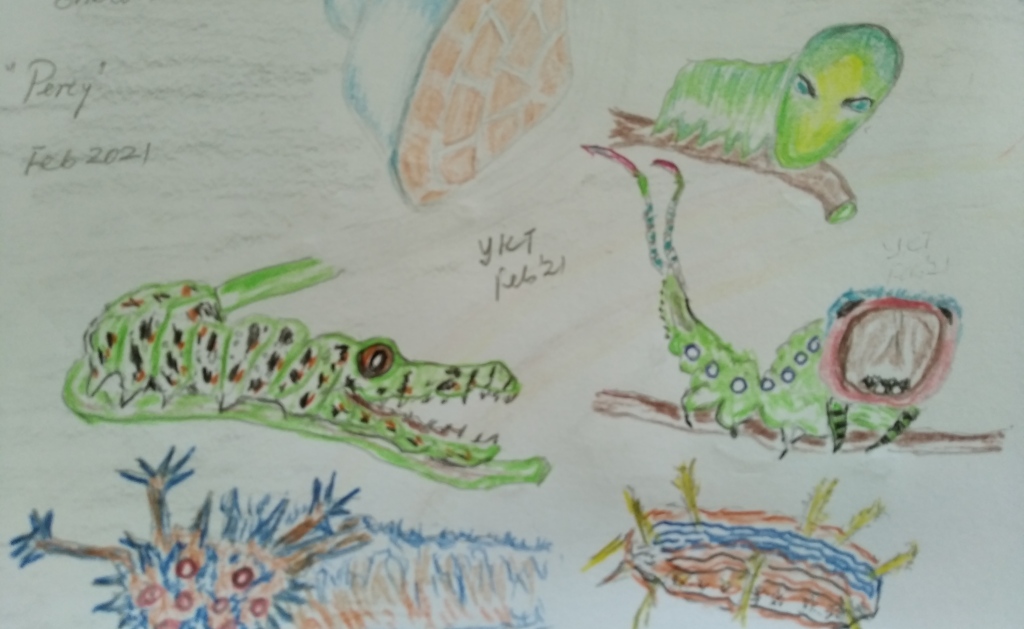
“Whoever reaches the ant at the end of the large leaf wins”, proclaimed the ant judge.
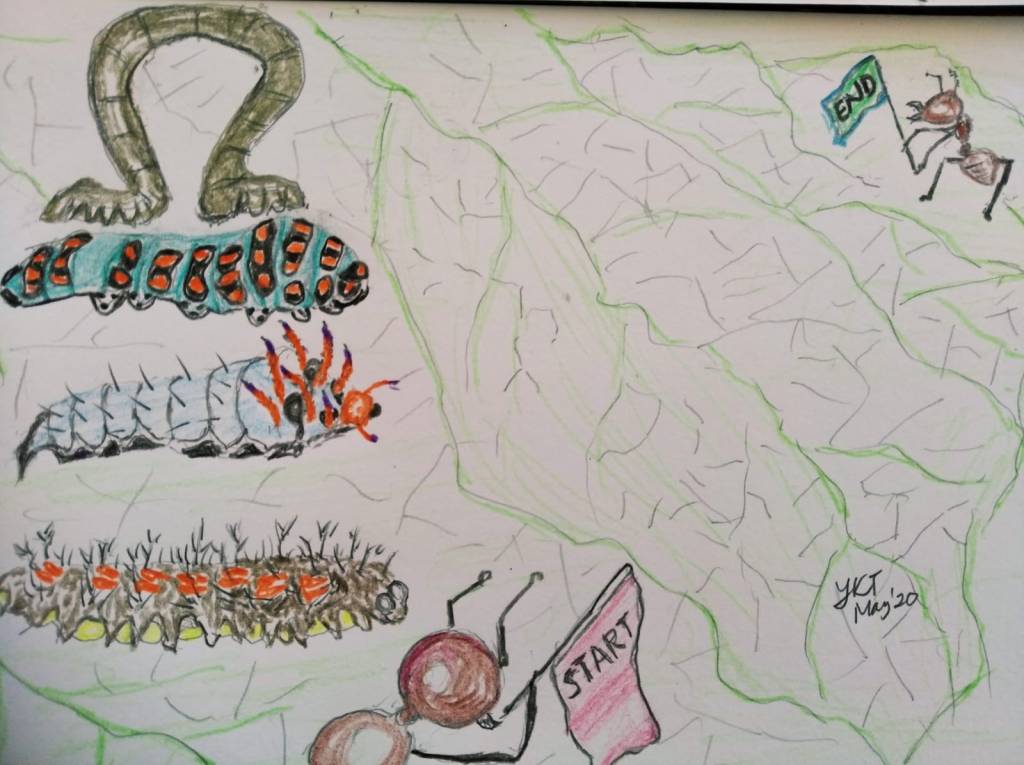
And off they went. It is obvious who the fastest is. The looper not only carries half its body forward at every loop but can also cross between adjacent overlapping leaves. But just before he reached the finish line a strong wind blew on the leaves and a sudden downpour of showers threw everyone away. All had to crawl to safety on the forest ground before a predator discovers a litany of grub. Indeed a jungle fowl happened to trudge by. Everybody scampered for cover – the race, now abandoned, became one of survival to hide under the fallen leaves. But the fowl has sharp talons – with a swift scratch it uncovered several larvae. For a moment the swallowtail thought his life was at stake. But all of a sudden the cockerel stopped, its wattles quivering.

Someone was watching from a tree. As it turned its comb upward the owl glided towards its target. For a moment the two birds fought – only to end when the cockerel flew in retreat.

So the fallen grubs crawled into holes and tree-barks to begin their transformation. Some got eaten before turning pretty. They fuel the enduring race to renew to the next generation of birds and insects. But one fact does remain – once a worm does not mean always a worm.
Beggar thy badger
Not many realize that the honey badger (mellivora capensis), a feisty mammal the size of a marten fox is more related to the weasel. It also has a pouch, like all mustelids, though it doesn’t use it like kangaroos. They have sharp long claws and is a ferocious defender, often solitary or with a mate. This is a story about one named Puffy. Despite its name they are carnivorous and besides honey and fruits, feed on insects and other small rodent-sized mammals. Puffy however loves honey and lives next to the most famous apiary farm in South Africa. Although he doesn’t mind eating berries, shoots and insects, every time a waft of breeze blew from the apiary he raise his nose in desire for the smell of sweet honey. But a high fence keeps him out and the keeper will not hesitate to shoot marauders. Oh, “if only!” he would exclaim inside – the desire of his heart is even to have a sip of the smooth honey.

One day he was hungry and food was scarce in the season. Puffy had to hunt and even insects were hard to find. Then he spotted a field-mouse. It was all he had and he chased with all his might. Just before he could close his jaws on his prey, out of the bush sprung a cobra. Both had sights on the same prey but Puffy would not give up without a fight. Somehow his hide is so thick that the cobra fangs could not hurt him with its venom. After some skirmishes he managed to overcome the snake, and still had the mouse for a meal. After eating his fill, the smell of his dream honey floated over the fence. Puffy stopped eating, wishing that he could instead have his besotted meal. But not that day.
Another occasion food was scarce again for Puffy and he happened to walk past the apiary. Through a chink in the fence he could see the beekeeper smoking the hives in preparation to harvest the honeycomb. As the rich, exquisite, luscious fluid was retrieved and poured with the combs from the hive, Puffy could not resist the stream of saliva oozing from his palate. Then a loud noise from the gate jerked him from his daydream as a truck turned out from the farm, laden with the day’s harvest. Sadly, he turned to go, again robbed of a chance to satisfy his deepest desire.
So Puffy spend his days eating what he could, until he chanced upon the deepest desire of his heart – wild, delectable, salubrious honey hanging from a large hive off a tree. But it was too high for him. He stood there gazing at the swarm and licking. What now? For how long he stood there nobody knows. Then a chance. Out of the woods a tall brown bear emerged. Obviously he also smelled the taste of honey and decided to paw at the hive. Swarms of angry African bees went into attack, stinging the bear’s face, nostrils and whatever open skin available. The bear reeled from the onslaught and stumbled off. But not before breaking a small piece of honey comb from the hive. Now it was Puffy’s chance. As he picked up his treasure with his jaws the swarm of even more angry African bees descended on him. No problem, that’s why they are called honey badgers. Puffy tasted a tiny piece of heaven that day. But it was just enough to make him longing for more, much more. Talk about gluttony and uncontrolled urges Puffy was in that state. He got himself caged for unfulfilled desires. But a week later he was about to be delivered from his “cage”.
Puffy was digging at the foot of a tree. Insects were the lowly meal of the day. Again he heard the noise of the apiary gate opening and the smell of freshly harvested honey. He stopped and perked up his ears as the truck slowly turned out of the fence. For some strange reason he decided to follow and trotted slowly behind the lumbering truck. As it speeded up on the bumpy country road, its wheels abruptly hid a loose rock on the road. A crate fell out from its rear, but the driver seemed to had not noticed it. Puffy stopped in his tracks as streams of the finest honey of South Africa flowed down the muddy road. The wildest dream of his lifetime stared at his face and the deepest and wildest craved ecstasy was about to be fulfilled. He had never used his tongue so much in his life. On and on he licked silly until he started to burp. Then he trotted off into the woods in a daze. As he settled down at the shade of a tree he started wondering about the bizarre event that just happened. “I’ve been dreaming of this my whole life to eat as much honey that I craved. Yet it didn’t seem so special after all. In fact it appeared so ordinary – so un-special.” Puffy had just hit on an experience many humans faced. It could be that dream job, that dream vacation, heavenly food or aesthetic drink. For the young man who experienced sex for the first time after marriage, or the first mad kiss with the person of the deepest desire that they had for so long. Yet after having it it was just ordinary – nothing that special. They were in a daze when they had it. Now that they had it they began to ask why they desired it so much. It was just the fantasy that made it all so unreal. Unexpected pleasures are the most extraordinary blessings.
The mantis who didn’t pray
With over 2 400 known species the mantodea has a reputation if you’re still unaware. They are lightning fast slashers, sees in 3D, are masters of disguises and are known to battle spiders, lizards, birds, frogs or bats. And they are picky eaters, preferring live bait. They produce many eggs during a 3-hour saucy mating session, which might even end by eating their mates! But unlike females, the males can fly away.
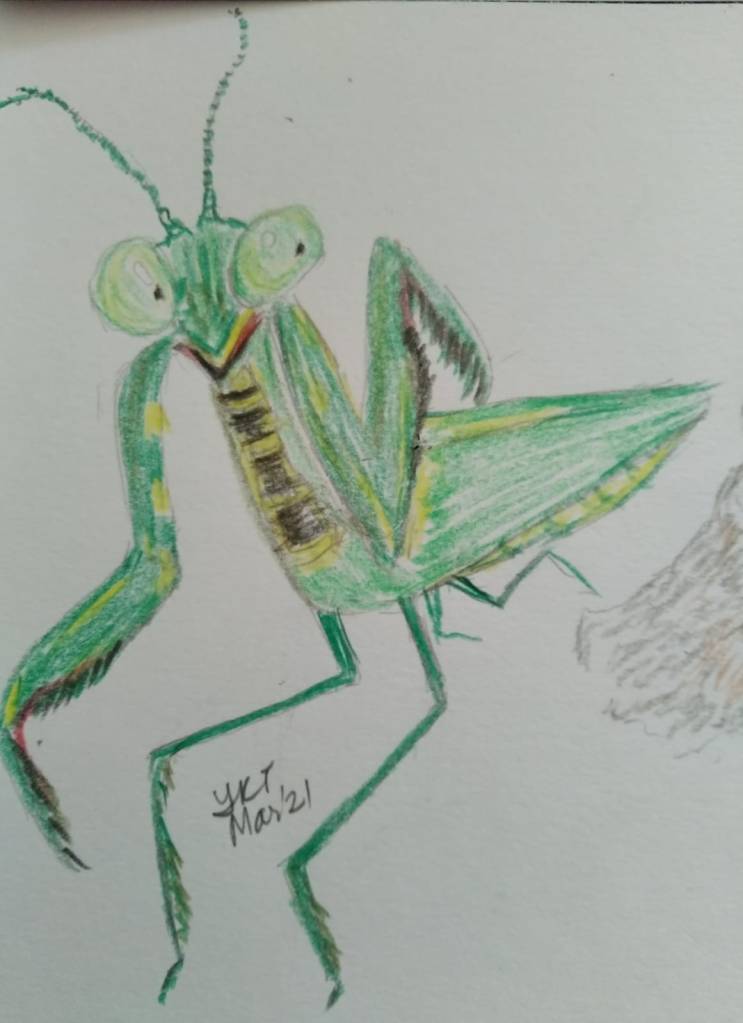
In a garden at the opposite end of where Slasher lives is the antithesis of the mantis. The humble ladybug (coccinellidae) goes quietly about her business gobbling up the minute aphids and their numerous eggs that are anathema to all the plants in the garden. After gobbling up most of them in a stem, she slowly opened her vermillion-colored wings and quickly disappeared to another nearby branch.
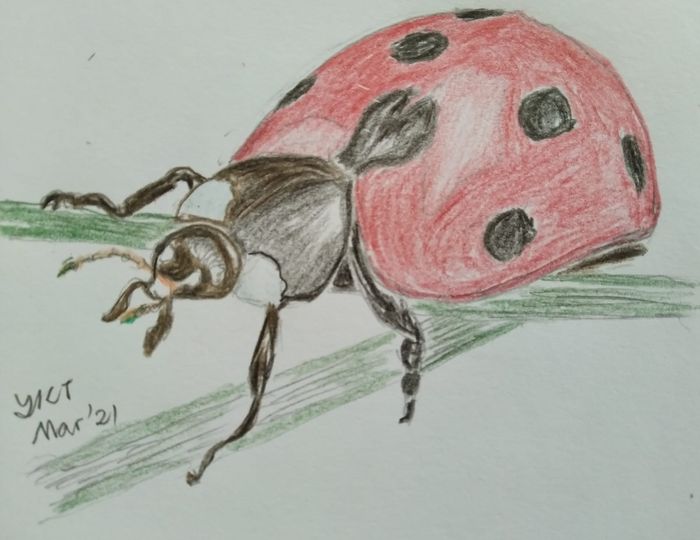
The Ladybug was introduced by the gardener whose sugar-cane plot was almost demolished by the fast breeding aphids. So when Ladybug landed on the sugarcane stem dozens like him were already there cleaning up the aphids. Trouble is when there are lots of insects there will also be insect-hunters.
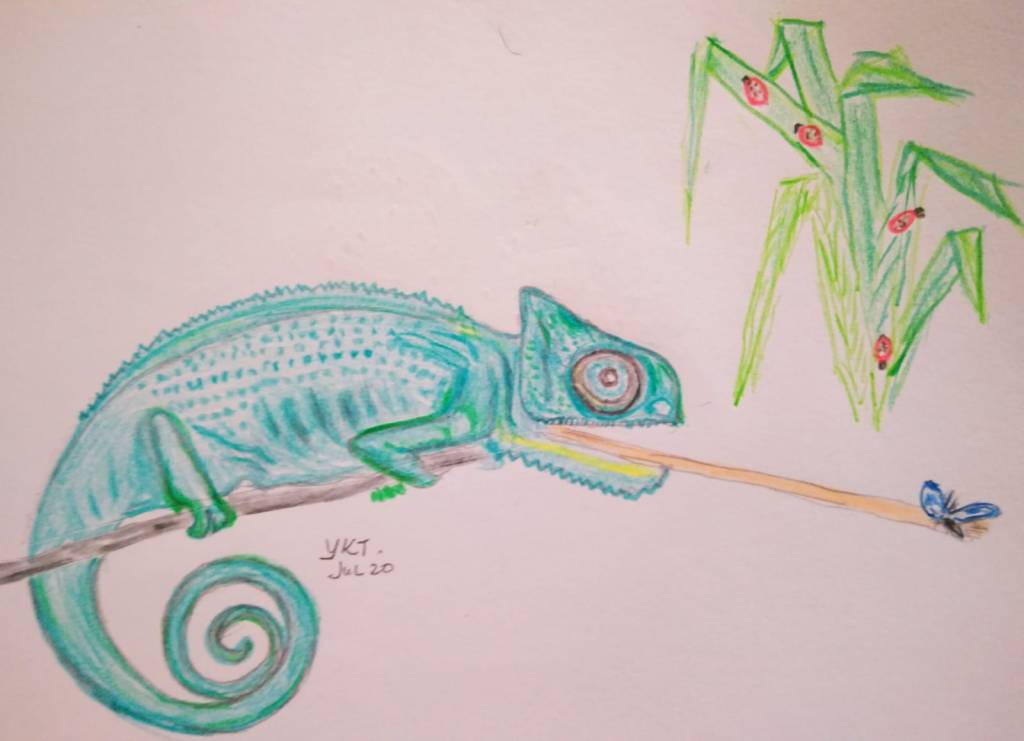
With his long spit the chameleon can easily reach the ladybugs from where he sits. But someone stood in his way. The Slasher was also interested in the ladybugs. Before the chameleon could aim something slashed at him from the back. It froze and turned to meet his attacker. Although he doesn’t have a formidable weapon as the mantis he had something far superior – his eyes can see 360 degrees and the left and right eyes move independently, whereas the mantis only sees in 3D. As the mantis approached to give another more powerful strike, the chameleon rolled both his eyes up and down and left to right. Then all of a sudden he jumped from the branch and scuttled away under a bush. Now the mantis next thought she had the ladybugs all to herself. As she clambered towards the sugarcane leaves from above came a whoosh of wings. The mantis looked upward, waving its fearsome claws at the descending bird. But the odds against the powerful talons of the Shaheen falcon are dim.
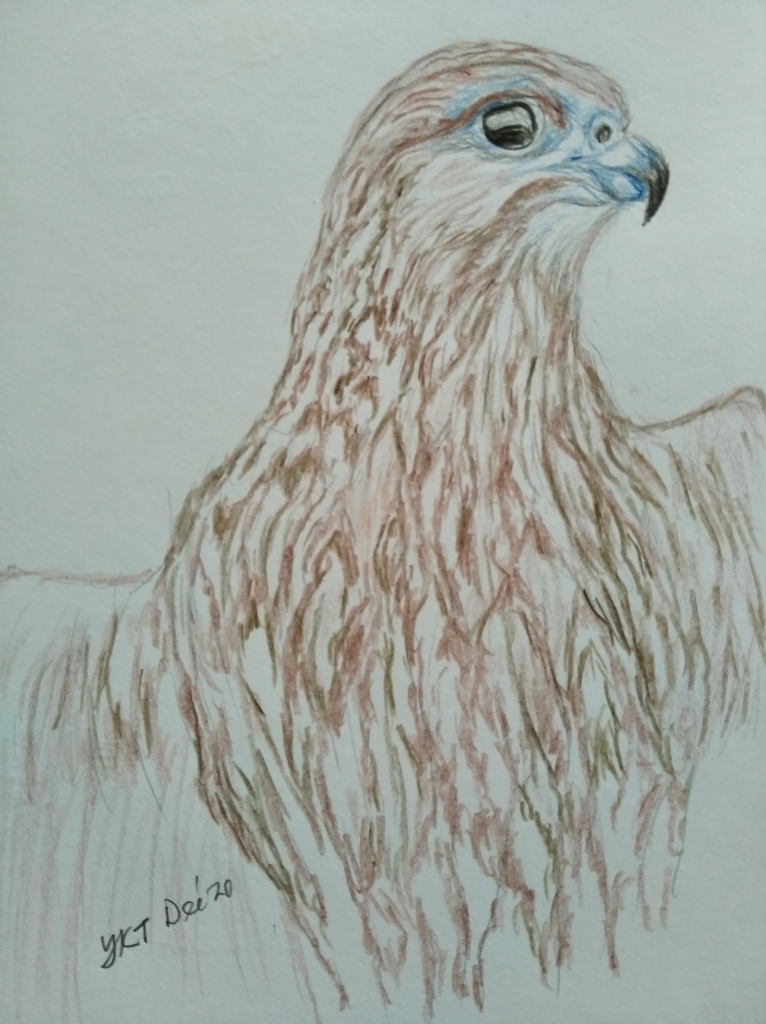
Once again predator became prey. Or should we say the mantis should rather be praying than preying. And there’s another lesson from the chameleon. Know who are your real enemies. What about the ladybugs? After polishing the sugarcane leaves of the aphids and their eggs they must turn elsewhere to feed. They also feed on vegetables such as lettuce and similar vegetables. And that’s where the farmer kept his gang of chameleons to control their growth. But when one chameleon turned to aim his spit on a juicy bug it turned its back and rubbed its legs – a secret weapon emerged. Instantly a foul-smell filled the air from its secretions. There are about 38 chemical compounds, mostly methoxypyrazine (DMMP or IPMP) that will really hit you. “Don’t you eat me, I smell”. Or more correctly as Johnson would have said to Boswell, “Incorrect, you smell me but I sting!” And so often in life not everything one possesses, such as a flawed character, can be loved by all – an offensive quality inherent in the ladybug turns out to be its lifesaver. And there’re some species of beetles that sting or secrete an offensive feces to thwart its predator.

The camel that refuses to run
Humans have a tendency to compete or to rise to a challenge. While inherently this is a good thing when it comes to a wager on a race it must seem that humans enjoy it more than animals. Horses, greyhounds, pigeons and camels come to mind. Horse racing is a US$39 billion business in USA alone in 2013 and greyhounds bring in about $339 million annually in NSW Australia. What of the participants? Does it contribute to their well-being other than being a wage-earner? Shahid is a young camel raised in Melbourne Australia. Yes they race camels there, and a more prestigious event than in the Arabian states.

Dromedaries are known to be more intelligent and emotional than horses, although they may not run faster. Shahid had decided that he’d rather walk than run. His owners found that out at the first two of his preliminary races. He’s of a fine breed and stature and his owners were full of hope of his potential. However at the first race, he decided at the gates to turn back to his stable. After sessions of coaching and remonstrations, he went into the second race. He did well, leading the pack from the start. Then just before the finish line Shahid somehow decided he had enough, as if to say, “I quit ! I won’t do this nonsense again!” And so Shahid from that day on refused to bow to his driver or rider.
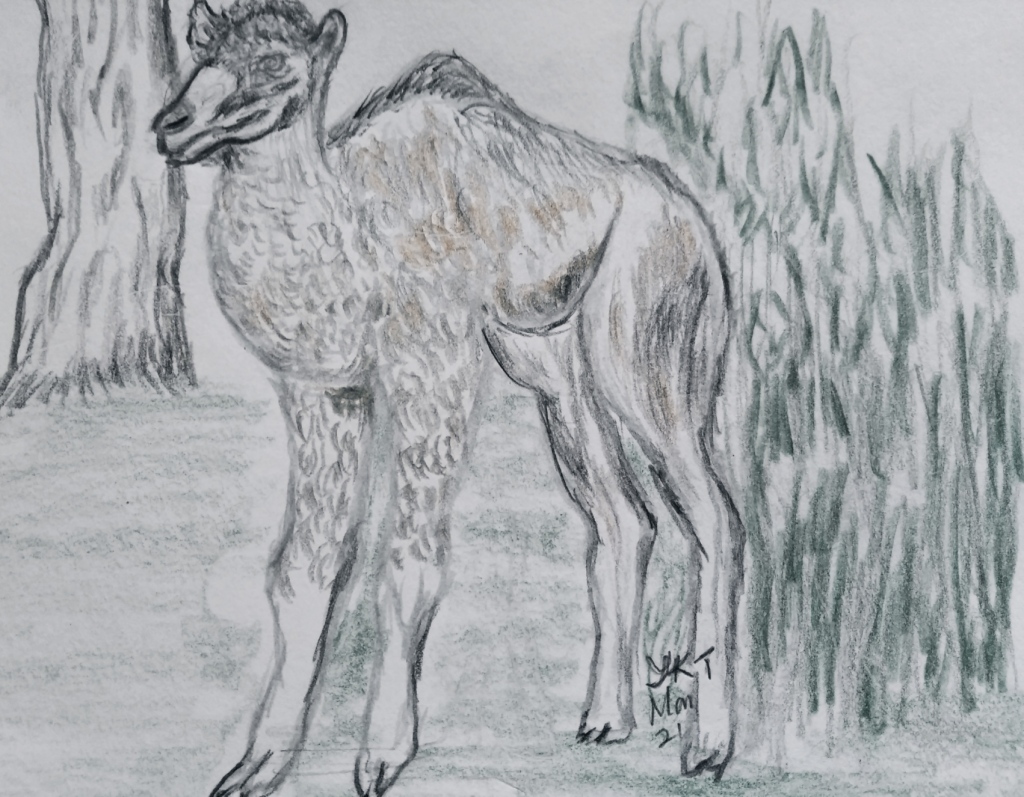
What would Shahid do then? His owners were at a loss, thinking that he would rather resign to being a beast of burden. That was until he met a friend – a young donkey named Don. He was still a baby in the same farm where Shahid was raised.
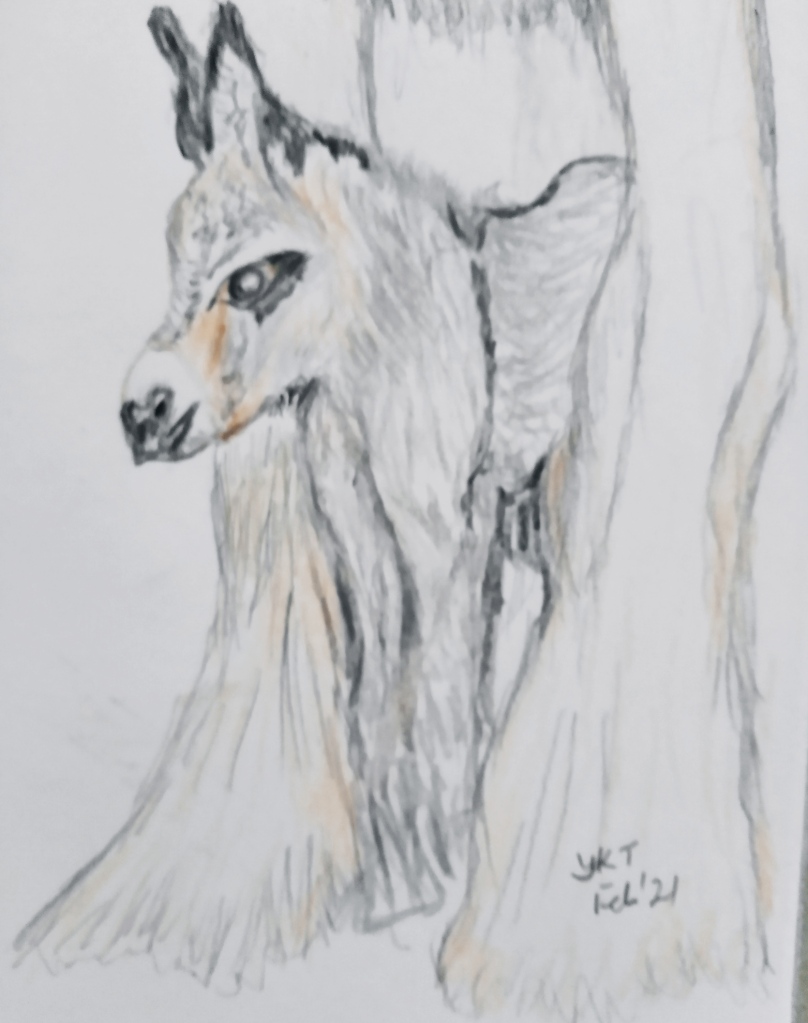
Don loves flowers. As a week-old baby he would run from flower to flower, sniffing or eating the petals. One flower he especially likes are azaleas. At the farm he would visit the azaleas patch with another and would sit and watch them with Shahid. Why would they do that? Turns out that their owner Mr. James Ditty loves them a lot and that’s why Shahid was not send to work as a laborer. So they returned his love by being with him as he tends to the flowers in the farm. Like pets to him they would bray, bleat and cry whenever it is time to walk the rounds in the orchard. Then one day James was taken away to a hospital. He had fallen to a chronic cancer-linked ailment. The animals still walked around the orchard, smelling the flowers of hope. Azaleas became a habitual stop.

After some time James didn’t return to the farm and one day Shahid and his friends overheard someone saying the donkeys and camel have to be sold. Sadness filled their hearts as beasts of burden have hard lives and are generally abused. The more the trio went to the azalea patch, hoping for the best. Then one day a visitor came with her little daughter. “Mommy, so cute, can we have them at the school?” The mother, a superintendent of a day school for children replied she’ll think about it after speaking to the widow of James. And so the flower of hope has given the trio a ray of hope. Shahid and the young donkeys became pets for the day school children. The kids were gentle to them, as instructed by the school head-mistress being the requirements for their approval at the school. Every afternoon the children would scream delightfully riding them and even take turns to bathe, feed and clean the animals. For Shahid and the baby donkeys there couldn’t be a more pleasant job entertaining the kids. Definitely better than racing or bearing heavy loads.
Tiger in the tank but none in the wild
The last roaming tiger in Singapore was shot in 1930. Unlike the Esso sales notion that a tiger in the tank will make your car purr powerfully, the panthera tigris is actually shy and fearful of humans, fire or unfamiliar sounds. Their beautiful orange-yellow coat of black stripes, with a white underbelly is unique and the animal has been a mystical subject of folklores throughout history ranging the Western and central Asia to the Amur region. But today there are more tigers in captivity than in the wild – about 3500 individuals red-listed by IUCN as endangered. This is the story of Toby, a cub rescued after his mother was snared in a wild boar trap in the Sundarbans, a mangrove forest in the Ganges delta of the Indian subcontinent. Fortunately the mother survived but Toby had to be cared for. A project was started to see how Toby can be raised to be returned to the wild. Bengal tigers are larger than the other panthera species and Toby grew to be a healthy adult. And the keepers of the zoo faced several challenges before Toby could be released.

When Toby’s claws and fangs were fully ready, the day came for his release. So with a last good meal, radio-tagged and his teary wildlife biologist watching with binoculars, Toby walked free into the Mangrove swamps. The first few days were of a curiosity for him. He would walk round the sanctuary fence, wondering why his human friends left him. But he got hungrier and a newbie at hunting. He tried chasing small rodents but it wasn’t easy unless he learns to stalk. Then he went into the water – swimming is natural for tigers. Nothing. Except for some mud-crabs he stumbled across the mangrove roots. That was his first meal in 5 days. After a week they sighted him again. The biologist was almost in tears seeing his shaggy form. She was about to go retrieve Toby when her colleagues stopped her – give him few more days they said. So they drove off sadly, but not before Toby realized his human friends, source of food was nearby. He gave chase, but soon lost sight, or smell of the vehicle. Another week passed and the biologist was anxious. But they couldn’t find Toby at first. After several hours tracking they saw him, or what became of him. His whitish fur have blackened and his skin sagged over his bony frame. He walked slowly, what looked like a slight limp. Anyone seeing what happened to such a majestic animal would have been moved. The wardens decided that he had to be saved again. When Toby was carried into the vehicle, it was purring with joy and the biologist was weeping.
So they brought him back to health but decided he must go through jungle training. They tried live fowl, rats, rabbits and even a wild boar to see if Toby would learn to stalk and kill. It wasn’t particularly effective – Toby lacked the instinct to kill and besides he had his human friends. He would eye his prey with curiosity instead but turn happily to his wardens after the exercise. What to do? The wardens realized that there’s no such training for killing to satisfy hunger. They tried fasting, but Toby cannot be untaught that humans would not be his savior. Then one day, success. After going hungry for hours in the sanctuary they watched from closed-circuit TV that Toby managed to catch a squirrel. Then a jungle fowl. Elated the team prepared to release Toby into the wild again. This time he did not have a pre-release meal but Toby will have daily surveillance instead of once a week. Then during that week Toby succeeded in hunting small prey. Knowing this would not be enough for his 120 kg frame, the team decided to leave larger carcasses nearby when he’s out of smelling range. So the arrangement worked, with the hope that Toby would then learn to stalk wild boars or deer. But something drastic was about to change the warden’s plan.
They were watching Toby at night as he hunted. Then something came into view in their night-vision binoculars. Humans! And they were not friends. Toby wouldn’t be able to tell apart poachers from game wardens. The biologist and wardens quickly started the engine and took out the bullhorns. Speed was of essence because poachers would kill even a friendly tiger.
The flashing headlights of the Jeep and the sound of the bullhorn was too terrifying for Toby that he disappeared into the bush, while the poachers ran the other way. The next morning they went out in search and found Toby crouching in the undergrowth, unsure at first whether it was the same humans the night before who came at him with guns. Then the biologist softly called out his name. At the familiar smell Toby leapt from the bush in joy. He had not seen them for weeks. Can you imagine a 120 kg tiger hugging you at full height? Everyone wept at the reunion and Toby couldn’t stop purring.
So ended the program to return captive tigers to the wild at the Sundarbans. The problem was not there weren’t enough tigers in the wild. There were just too many greedy human beings.
Dream of the black panther
Leopards and jaguars are called black panthers (panthera padus) because of the color of the fur. But closer examination can reveal shades of black, due to pigment melanin variations in the skin and fur caused by recessive genes. Depending on the angle of diffused light one can spot spots of the leopard coat pattern and can even appear dark shiny blue. Panthers are shy and reclusive and can be hard to find especially when hiding in dark enclosed places such as drains. But an animal-lover have befriended one such character and have attempted to revive the endangered creature. Jamal works in the rubber plantation of Southern Malaysia. Large tracts of Malaysian forest turned plantation used to be home of the Malayan specie of black leopards. One day Jamal happened to be resting in his tapper hut when he thought he saw a dark shadow among the trees. Fascinated he tried to be as quiet as possible to know the animal better. When he had a full view of the big cat he was determined that he must ensure its survival and well-being. Knowing it must be hungry he threw some of his uncooked chicken that he had bought at the local market earlier and hid from view. His kindness was rewarded when the hungry animal came near him. Jamal decided he must protect the animal from poachers and trigger happy hunters. But he had to have some photos in order to get the help of the Wildlife and National Parks. Being poor he had to borrow a cellphone and wait for his animal friend again. He had to wait a long time. After several months he decided he must return the cellphone to his friend. But on that same morning he saw it again. This time it came straight to his hut. Jamal quickly got out of sight, but that wasn’t a morning for groceries. He thought of throwing some beef jerkies he had for snack, but decided against it. After a while the panther jumped off in absolute furtive silence, but not after Jamal had his photos.
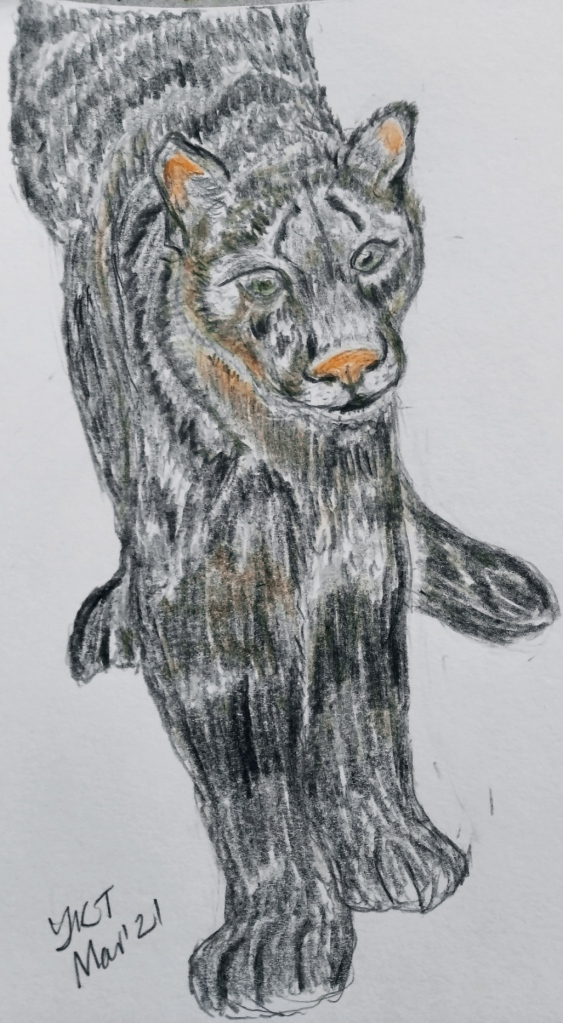
The Malaysian Wildlife was very supportive and offered Jamal a stipend to help watch and perhaps later to capture and tag its livelihood. The money was helpful but Jamal was not so keen to help capture it. Until he had a dream.
He was resting at the hut after a hard and hot day. He saw villagers, some with guns and sticks approached the hut. The village head ordered him to get up. “Your panther had been stealing livestock and we are here to track and kill it if possible.” Jamal pleaded, even went on his fours to spare his nightmare friend. Please, give me a chance to get the government to help first before you shoot or trap it Jamal cried in desperation. Just then there was a shout as a villager pointed excitedly to something among the rubber trees. Several men with guns went after it and shots rang out. Then Jamal awoke, sweating. Later that day he was on the phone to the Malaysian Wildlife.
The plan was for Jamal to keep feeding and luring it to the hut while they set up an overhead net. Jamal was still uneasy to betray his friend but was convinced seeing it alive was better than being trapped and killed by villagers. So for months he gave fresh bait and after many attempts came to know its habits. It was even willing to come to the hut when Jamal wasn’t in hiding, usually in late evenings or when the weather cooled. So the day came to set the trap. Jamal gave it an exceptional good meal of pork and lamb. When he slowly tugged and tripped the net over the panther, the ferocity and anger that ensued melted Jamal’s heart. He even looked directly at its greenish eyes which seemed to accuse him of betrayal, deception and treachery. So Jamal became the guardian of the tagged panther after the Malaysian Wildlife officially appointed him and informed the village chief. The plan is for Jamal to feed it enough so that village livestock is not threatened. Jamal is so familiar with it that he could even pat it. Then a warning from the authorities. Jamal have to avoid being too close as there are still poachers around. Then came more disconcerting news. The Malaysian Wildlife was made an attractive offer by the Singapore Zoo to buy the panther. Jamal refused. “Malaysia still has its legacy of a rich wildlife because we value our forests, while Singapore powered ahead to being economically superior, killing the last magnificent tiger in 1930. The last time you killed a Malayan black panther rather than save it after it escaped your zoo. Your roaming wildlife today is just a dozen or so otters. This panther will be happier in our natural forests than being couched in a showcase zoo. Your citizens and descendants may be more affluent and clever but we still have the soul of our wildlife as our legacy.” Powerful words from a poor tapper.
Arawana talk
The global ornamental fish industry is worth $12 billion and will reach $26B annually by 2026. The USA and Philippines are the greatest importers (65%) while Singapore is top monthly exporter of over 1000 aquarium fish. Besides the common goldfish, many varieties are air-flown worldwide such as various angelfish, discus or the clownfish. But the crown jewels are the koi and the Arawana whose trade belongs to a class of its own. Kathy Chow owns an Arawana – the golden type that costs thousands. No – not in that round fishbowl below – the prized fish lived in a large aquarium in the living room.

But she does have goldfish and a cat. So what actually happened? Earlier in the morning when she usually feeds her pets she got an urgent call from the office. Dropping everything she got to work and was able to rush home at lunchtime to complete her chores. She seem to have just entered the apartment, kicked off her shoes, placed her handbag and got ready to feed Tabby and goldfish. Then she felt she must go to the toilet. On the way she passed the living room. A quick glance at the aquarium she felt a sense of horror – the golden arawana was missing! After the toilet she noticed the trap-door at the back entrance door for Tabby was wet. Also the bathroom top window was left opened, probably unwittingly by the aircon serviceman the day earlier? The floor next to the aquarium was wet, but no other traces and the other fish was swimming normally. Did Tabby eat the fish? Or was there a thief? How and when?
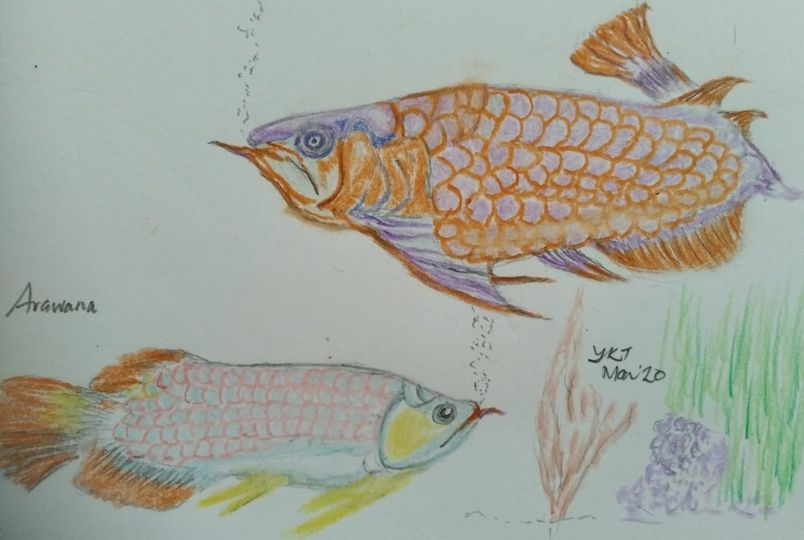
She went to Tabby first – it was purring and hungry for her missed morning meal. “Tabby – did you eat the fish?” she burst out. But when she placed Tabby’s meal before her, it devoured greedily. Then why was Tabby’s trapdoor wet? Thinking that she should be making a police report she next went to close the front door which was left opened. She heard people speaking loudly outside, which is the lobby area of the apartment. Curious, she inquired what was happening with the police around. On seeing the lobby pond she suddenly realized what happened. The security guard said overnight many of the carps and koi were missing. The culprit? Security camera show them frolicking with a full stomach at the landing.
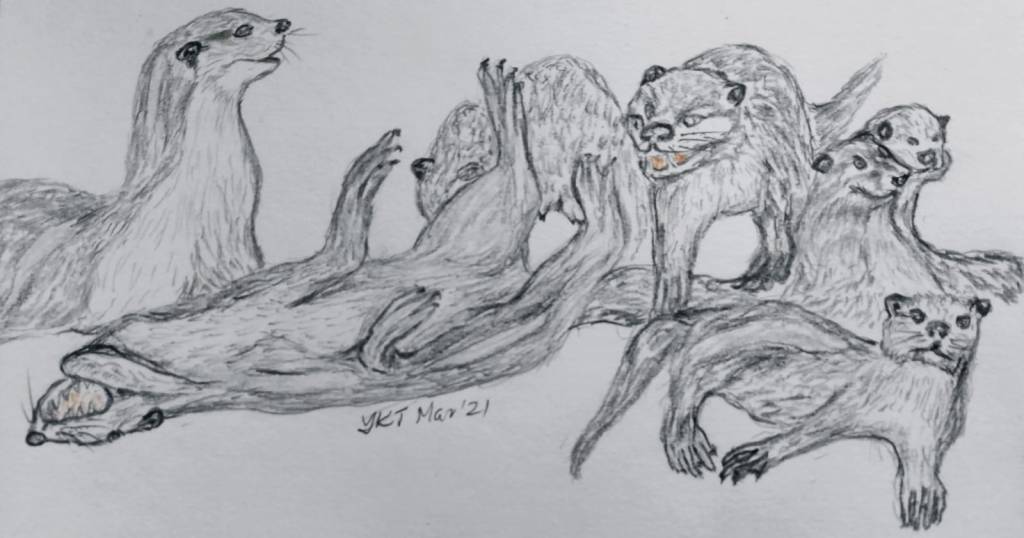
Kathy was torn. Being such an animal lover she thought that if she’d reported to the police they would be guilty of house-breaking and theft. They are after all Singapore’s only roaming wildlife left. The price for having the curious lutrinae (canadensis) amphibian right at our door-steps in the midst of advanced economic development can be high.
Kathy got another arawana, a less expensive one. She was fortunate that she had insured the last one although she had to make a police report to make the claim for theft. And the trapdoor ? Kathy made it into an exit-only for Tabby. At the end of the day the cat would wait for her at the front door to be let in. These days she’ll hug her cat who’d welcome her home each day. The event had at least brought cat and owner closer. Several months passed.
One evening she came home about the same way – after she let Tabby in, she kicked off her shoes like before. Then she closed and locked the door. This time she had her boyfriend with her. Wonder who will enter (or leave) by the trapdoor now?
Savage lessons from the Birds
The Potoo lives in South-Central America while the Shoebill hails from East-Central Africa. Both stork-like birds uses entirely different defenses against predators or prey. The prehistoric-like shoebill (balaeniceps rex) can grow to a meter tall with an imposing giant beak. It feeds mainly on water-based creatures such as frogs, fish and small crocodiles. They appear gentle but might have a nasty bite to humans. It uses its large wings to fly low over swamps for prey.
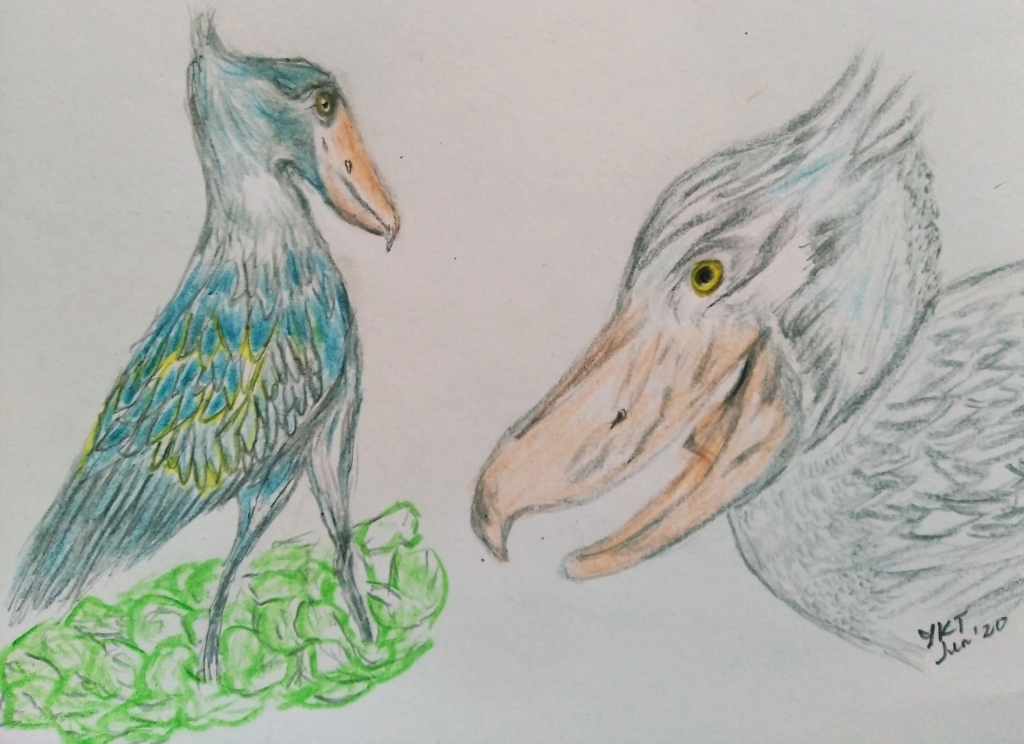
The great potoo (nyctibius grandis) however is a master of disguise. About half the size of the shoebill, potoos hunt insects and small bats. However they are shy and would rather avoid anything using their camouflaged posture like a tree branch.

When threatened the potoo will quickly open its large mouth to frighten its predator by its imposing figure. Although both birds originate from continents apart, you can likely find them at the Jurong Bird Park. That was where bird-lover Kenny, 12 and his father went one day. They bought the ticket to walk close to the big birds. Near the Potoo enclosure Kenny was trying to lean on a tree much like the one on the left in the picture. Then suddenly the branch at the top moved and both father and son were shocked to see the owl-like creature with large yellow eyes. Kenny was so intrigued that he tried to reach out to the bird. Then another shock – it suddenly opened its mouth so wide that you’d thought it was going to swallow you. Father turned to his son and quipped – “Don’t take first impressions for granted.” They then walked to the next exhibit. They could see the shoebill in plain sight – taller than Kenny’s height of a half meter. Next to it was a nest of two young chicks. The mother was feeding them with worms caught after flying back from the pond. But the bigger and stronger chick kept getting the grub from the mother and pushing the younger away. Kenny was troubled and asked – “Daddy will the little one die of starvation?” The father didn’t have an answer but kept looking how the parent will be fairer to its young. Then suddenly the bigger chick started attacking the younger – biting it fiercely and attempting to eat it up. “Daddy – please do something!”, Kenny was almost in tears. But a warden soon appeared and rescued the half-dead younger. “Don’t worry – we’re all watching from the camera. In the animal world the stronger chick always eat up the weaker one – that’s the law of the jungle – to ensure at least one will survive. We wanted the younger to spend as much time with the mother, but we have to rescue all chicks of this threatened specie.” After the explanation both father and son were silent and thoughtful. Finally the father spoke up – “Kenny, make sure you’ll always protect your younger brother – we’ll always have enough for both of you.” They walked to the next enclosure. The sign says there is a rare bird in the enclosure and challenges the visitor to see if they could spot it. They spend quite a long time staring up and down the bush in the enclosure. Bored, Kenny gave up and wanted to go to the next enclosure when a warden walked by. So the father asked him to point out the bird.

It was quite easy once they identify which branch the bird stood. It turns out that this secretive, elusive Japanese night heron (gorsachius goisagi) will avoid all living things, especially humans. Because of habitat loss, its numbers have fallen to the “protected” category. Just like the Potoo, it has the instinct of disguising itself like a branch, staying stiff like a statue until the danger has passed. At this the father turned to Kenny to tell him of a wisdom from the heron – “When in doubt – stay still until the picture is clearer.”
A conversation in the mountains
If you’re ever inclined to take a long walk into the mountains know for certain that various therapy await you. Aside from the cooling change and the cleaner air the vegetation inspires. Trees give way to shrubs and flowers become timid in size, though no less pretty. The thinner air encourages waxy leaves and sturdy, gnarled branches to conserve moisture and heat. Even the mammals adapt with their furry coats and fluffy-covered feet. Two of the cutest tundra-bound that sojourn in these heights are the shy pikas and the even more shy and diminutive klipspringer (oreotragus) goat. Two pikas (ochotonidae) have been living on the same ridge up in the highlands of Malawi, SE Africa. Pablo and Santos share each other’s well-being. In the cold mountains there are a few predators who would take pikas for a meal.

The Steppe eagle is the most fearsome, and its attack can suddenly come from the sky. The chances of survival depends on how the pair warn each other of dangers. One day Pablo had a talk with Santos. Since they are swift-footed, and rarely is there more than one eagle on the prowl Pablo suggested that their chances of escape will improve if both are out together, by dividing the attention target of the eye in the sky. By running in different directions the eagle will likely be distracted. So they agreed on a strategy. When their sharp ears detect oncoming predators one or both would give a sharp alarm call.

Then both will run the same direction for a while before splitting to diametrically opposite burrow entrances. Usually the eagle would lose a few seconds in the distraction. In deep winter snow however escape from the snow fox requires a different approach. Usually the sharp ears of the red fox can pinpoint exact location beneath the snow. Pablo and Santos always have alternate burrow entrances and exits. When the fox starts pounding the snow at them, they already knew which tunnel to escape so that its snout cannot pursue beyond a few feet.

So Pablo and Santos made many escapades from bird and fox. But with time their discipline slacked. Pablo started going out alone when hungry. He had already re-eaten and re-digested whatever poo available, a process adapted to his existence known as coprophagia. One freezing day as he hungrily scurried in the craggy snow alone a swift shadow descended. With a characteristic shriek he leapt towards his burrow. Too late – the talons grabbed his hinds. Resigned to his loss Santos could only shrieked from his burrow, expecting the eagle to fly off with his pal. But suddenly something moved among the craggy rocks. The eagle was disturbed for a second – long enough for Pablo to struggle free. The eagle was not about to give up two possible meals. It tried to jump on the new animal – a klipspringer watching an African paradise flycatcher on a branch.
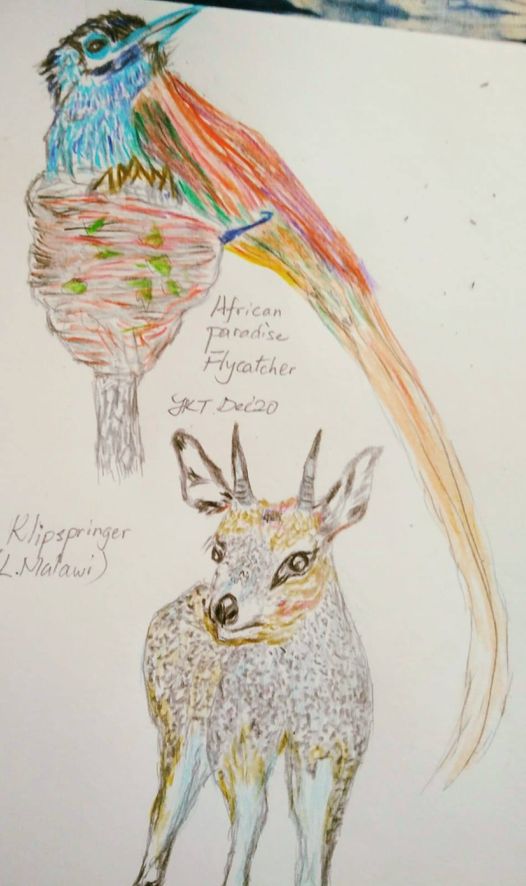
Again tough luck! The klipspringer, with an average size of 20 inches, is fast and elusive – so good is it at hiding that there are no records of how well is it surviving in the wild. Sure-footed, it skipped towards a cleft in the rocks. The steppe eagle hobbled on the large rock face, its large drooping wings flapping for balance. As it vanished within the ledge the eagle could only scurry about – the gap too small for its large wings.
The sky cleared after that snowy morning. You could hear then, as you will today the wild, abandoned shrill cry of the pikas as they clamber out of their dark burrows to collect seedlings and shoots. And you might even still see the graceful glide of the lords of the sky – the golden hawk eagle or the stately steppe eagle, eyeing in earnest of what prey they could catch for their young. But you will hardly catch the sight of a klipspringer. They only appear when something is in need of a saving angel.
